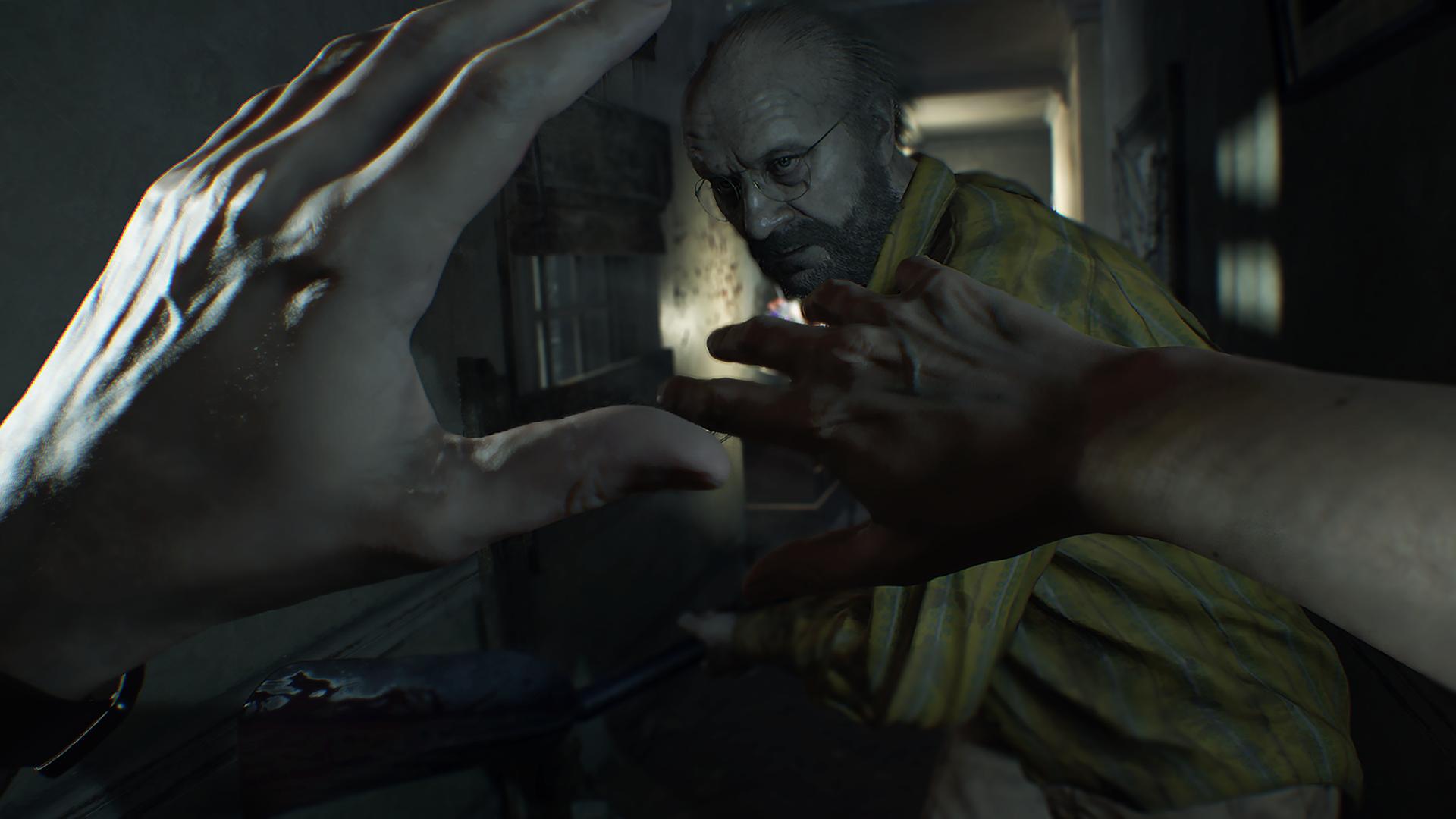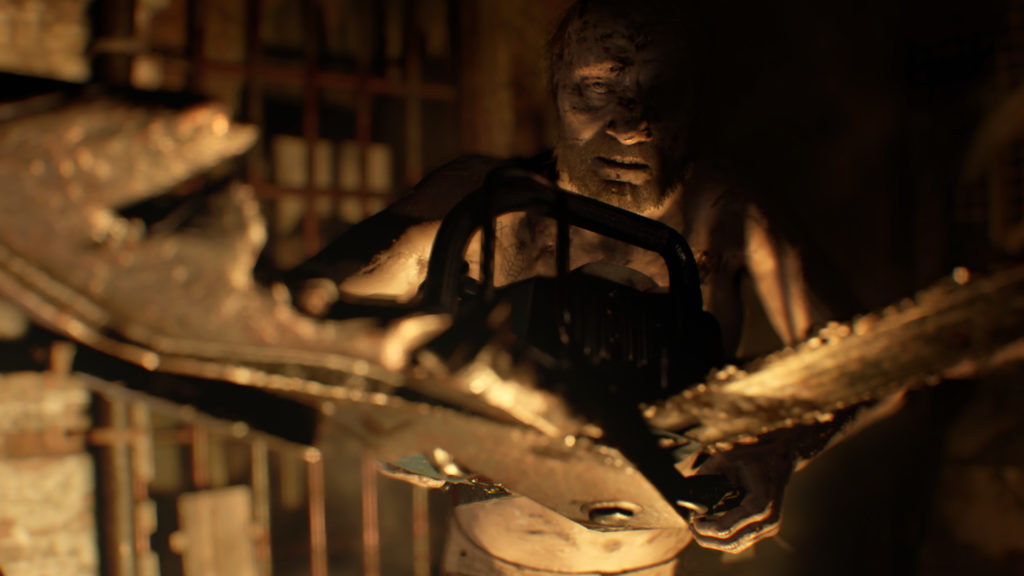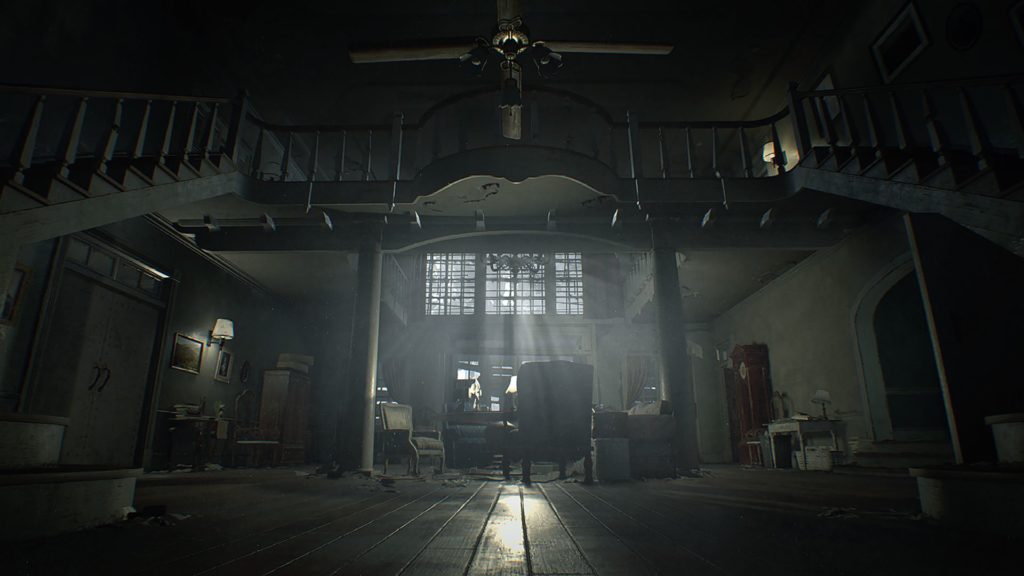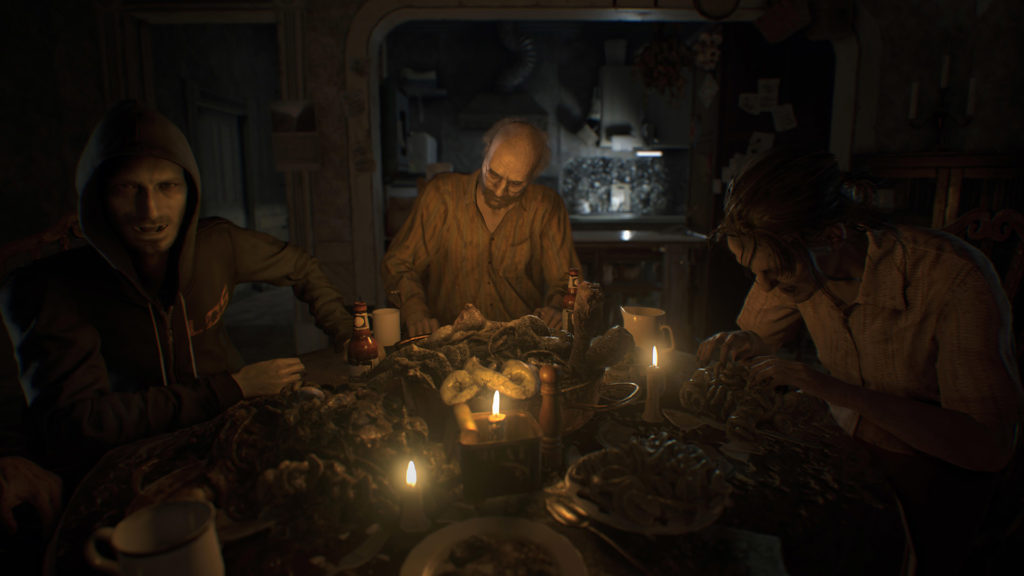If you really want to get a feel for just how terrifying this game can be, here’s an experiment: Simply stand still.
For one, silent second you’ll feel in control, but immediately, a simple action becomes a revelation. Almost as quickly as it arrives, the moment of self affirmation is immediately punctured by noise–environmental sounds start to ring in staccato, each one more unsettling than the last. The dull whine of rusty pipes, a loud thud on the floor above you to offset the creaking of an old house settling, or simply the steady pace of your character’s breathing (which, let’s be honest here, probably matches your own). Even when you stop, the world around you never does. Resident Evil 7 biohazard, even when you are completely stationary, doesn’t let up its assault on your senses for one moment.
Breaking the Mold
It may sound strange in 2017 to lead in describing a Resident Evil title with atmosphere as the main focus. After all, when a franchise undergoes as many changes as this one has, evolving over its twenty-year history from survival horror to a more action-oriented affair, would that be the first thing on our minds when thinking about an RE game? Examining the series from the beginning until now, I would pin 2000’s CODE: Veronica as the beginning of this shift, with its over-the-top cutscenes, dual-wielded weaponry and Matrix Wesker cartwheel flipping from walls. It all seemed really quaint at the time, but that is where we were four years into the franchise as a whole, and it was only the beginning as far as Capcom was concerned.
Gradually, the story broadened it’s scope far beyond Raccoon City. While the games themselves remained highly entertaining and still at times scary, this put Capcom in the position of needing to up the ante with each new title far beyond adding new creatures and codified viral agents to their lexicon. Longtime fans had the pleasure of watching series regulars like Leon S.Kennedy and Chris Redfield go from unassuming officers to full fledged government agents over the span of 6 main titles, and as time went on and they became more experienced, the gameplay took on a more unwelcome action slant that only served to make these same characters even more untouchable and doubly infallible. The infamous clause of empowerment that usually settles in the final third of an RE, nay, any horror title was now front and center from the moment you pushed start in Resident Evil 6, and there wasn’t any serious attempt to backpedal from the corner Capcom knew they’d written themselves into. It just became ridiculous.
When the games start resembling the Paul W.S. Anderson movies of the same name, I think it’s safe to say that trimming the fat is a necessary evil.
With that said, having the newest entry in a setting that’s unfamiliar, with an entirely new set of characters was a bold move. What’s more, to witness a minor backlash when this was announced was just puzzling. As far as I’m concerned, when the games start resembling the Paul W.S. Anderson movies of the same name, I think it’s safe to say that trimming the fat is a necessary evil. Resident Evil became what it was back in 1997 (and even more so in its fantastic 2002 Remake) not with bombast, but with a very controlled minimalism as far as its design. That minimalism relied on three things that I believe are integral to a successful horror game: An atmosphere that feels mysterious and foreboding, a roster of at-the-time unfamiliar characters whose motivations weren’t entirely clear, and an affecting, isolating character-as-setting–in RE’s case, it came in the form of the Spencer mansion. Say what you will about the creatures populating the halls, and underground laboratories that became staples from that point, all of this is simply window dressing to those three pillars, and in RE7, getting back to them meant trimming with near surgical precision.
It begins with the story, the raison d’être for our new protagonist, Ethan Winters. Three years after his wife Mia disappears without a trace, he receives a mysterious email sent from her email address, telling him to come and find her at a remote location in the Louisiana bayou. Far beyond the common sense that would befall any normal person, this is more than enough reason for our forlorn hero to set off into the middle of nowhere, and before you can say “Just how good was the booty?” he finds himself in the clutches of the Baker family.
It’s a setup that’s simple, but effective. Freed from the burden of needing to directly connect particular details of the franchise to previous entries (T-Virus? G? T-Veronica? Zombies? Ganados? Majini? WORLDWIDE BIOTERROR?) the dialed-back narrative surrounding these characters is given a welcome chance to breathe, and because they exist far beyond the shadow of previous characters, they’re given a reasonable amount of depth, and backstory that serves to flesh them all out. Aside from the main character Ethan, who is given very little so you can presumably project more of yourself onto him as a player, each of the Bakers are the opposite. Immediately revealed to be frightening as they can be grotesque, their unpleasant nature and customs hide connections to an even larger conspiracy that may not be as removed from canon as it initially lets on.
No Place Like Home
This would be a difficult juggling act to pull off if the game were set in a number of locations, Ethan’s journey taking him all over Louisiana while searching for his girlfriend, but restraint ruled the day among the RE team’s considerations, and much of the game takes place in one central location, one that undulates and expands as the game progresses. Much like the Spencer mansion in games past, you’re confronted with a sprawling environment in the Baker Estate that’s just open enough, but at the same time inaccessible enough to give you reasons to revisit old areas and explore, pushing against your captors as you struggle to find a way out. The fantastic visuals stylized to look like found footage give each area a grit and character that visibly decays as things progress, giving the weathered, worn estate a life of it’s own as you sift through the visible years of disrepair and neglect. Notes, diaries, and magazine articles fill out small details of the story as you explore. Even as you progress and learn the lay of the land, any familiarity becomes a blessing and a curse as you return to previously tread ground and find new surprises. There is definitely a classic RE sense of progression, and satisfaction at finding new keys and pushing forward, but the lingering mystery of what’s behind each locked door serves as an equal helping of dread as it does motivation to push you forward. For a (mostly) abandoned estate, it feels surprisingly alive, and that’s without taking into your gracious hosts into consideration.
Before the game was released, there was genuine worry that the game was leaving its biohazard trappings behind, and with good reason— having a more realistic kind of threat is a far cry from games past, and as I’d mentioned earlier, a complete tonal shift from what the series had become. The comparisons to horror tropes and imagery made popular by movies like Saw, Evil Dead, and Texas Chainsaw Massacre were all too apt a comparison here for an eagle-eyed horror fan, but not only does RE7 feed directly into these horror tropes to establish its universe, it does so with a series of delightful twists that affect the way the game is played at every stage. Jack is the relentless pursuer, evoking feelings of The Terminator (or the RE3 Nemesis) with a stubborn inability to be put down. Matriarch Marguerite is harboring a secret that allows her to control the insects in her house to deadly and obtrusive ends, and their unhinged son Lucas is an inventor with a knack for creating deathtraps and games of (little) chance for any traveler unlucky enough to wander onto their property. There are other threats lurking about, but they are used sparingly, and each encounter, each conflict, each bump in the night that startles feels earned, often occuring with an intensity that can leave you exhausted when you finally get a chance to catch your breath.
You Don’t Have Enough Space
I say exhausted, because despite the game being a surprisingly competent first person title, it doesn’t compromise gameplay for the sake of it. While the first-person horror conceit has been done to death since the runaway success of indie horror titles like Outlast, applying it to RE isn’t simply chasing a trend–here it works perfectly, and no, not just because the game can optionally be played in VR, it actually works on several levels: Not only does it cleverly bring back the classic tank controls that made the series famous by simply being an FPS, but the claustrophobia inherent in the game’s design—tight hallways, corners that conceal hidden threats, doors that crack and then lurch open to introduce another dreadful corner of the estate—plays off of it perfectly. When your back is against the wall, or you’re forced to hide from someone you know will find you eventually, it truly feels like you are cornered—and VR or no, the consistent feeling of being a physical presence in this world never leaves you. This persistent vulnerability, the everyman element that actually defined its competition in games like Silent Hill is present here, and handled well. It’s no small feat to make someone feel powerless even when wielding a grenade launcher, and kudos to them for towing the line with precision.
Before the game was released, there was genuine worry that the game was leaving its biohazard trappings behind, and with good reason.
Items are also given sparingly and in low quantities, emphasizing the value of each herb and bullet. It’s a first person title, but not intrinsically a shooter. Items are scarce, take up varying degrees of space in your pockets, and being constantly confronted with hard decisions about what to take or leave behind heralds the welcome return of item boxes, along with smart decision making towards handling every situation. There were often moments where I was confronted with a literal handful of resources, and when running was my only option, especially in first person, it made for some of the most nerve-wracking sequences I’ve felt in a RE title for a very long time. The unlockable Madhouse difficulty, available after completing the game once (Or if you reserved it, immediately, but take my advice—don’t) even becomes more than just a simple difficulty spike—it remixes the rooms, encounters, and item locations in a way that completely blindsides you and makes a replay in that mode as unpredictable as the first time.
I think it’s safe to say that I genuinely enjoyed Resident Evil 7. It’s a lean, effective horror title that masterfully uses atmosphere and classic survival horror tropes to great effect. Better still, they’re used in order to craft a compelling, engaging story with surprises around every corner. The most surprising thing about all this, is that it didn’t come sooner. When Capcom went in the complete opposite direction of horror in 2012, it was almost as if they themselves were declaring that the genre of survival horror was an outmoded concept, and should be abandoned. I’m sure whoever made that declaration was given a swift rap on the knuckles and sent back to their room, because when the fans voted with their dollars and the game still didn’t perform as expected, they had to go back to the drawing board, and reconsider their stance. The truth of the matter is that survival horror never died, and RE never needed to go in that direction to stay relevant. When indie horror games looked to the past of the genre and the response from the gaming public was overwhelming, the message couldn’t have been more clear.
This was what was needed.
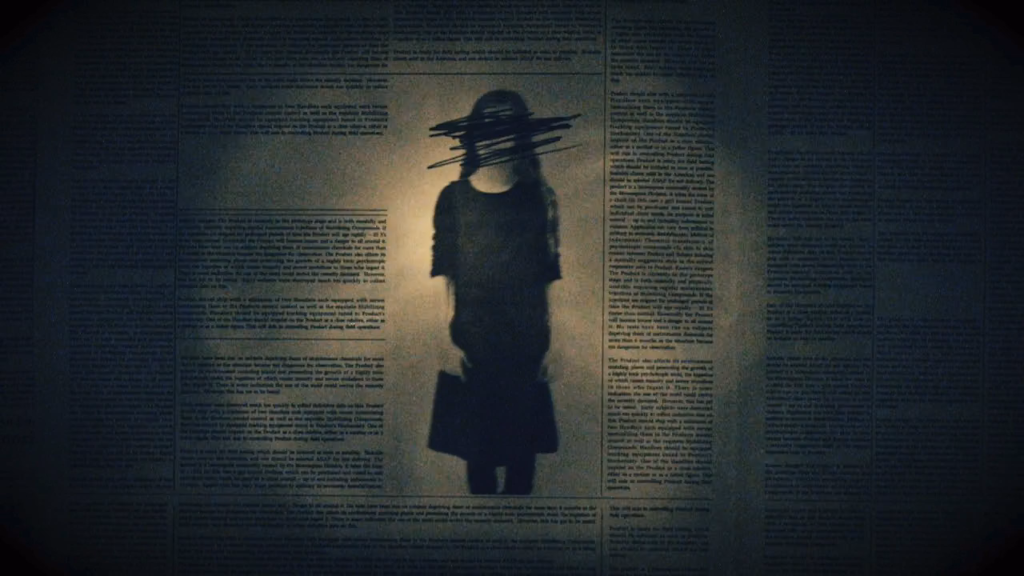
Is it perfect? No. There are definitely a couple of encounters that frustrate because the rules aren’t entirely clear at the outset, and the story is arguably too thinly connected to the Resident Evil canon to feel like a -true- part of the series, but that may be moot. I suspect they’re saving further details and connections for the upcoming DLC, the first of which releases February 14th. What matters the most here, is that aside from a wrinkle or two, Resident Evil is back, and for anyone looking for a great, effective horror title that bridges the gap between the old and the new in more ways than one, this is definitely a stellar effort from developers we knew had it in them all along.

